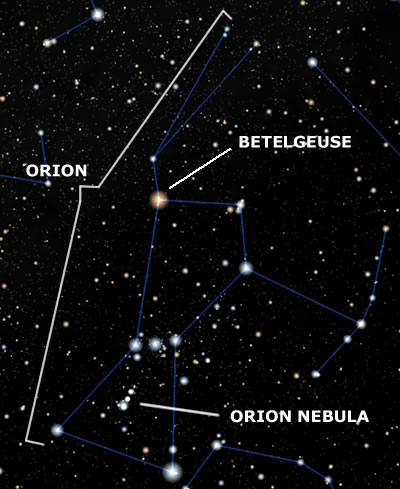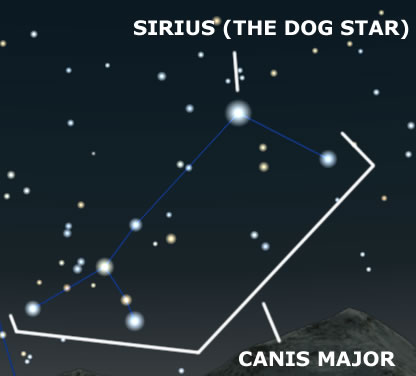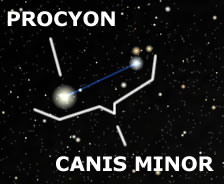Posts Tagged ‘meteor’
Perseid Meteor Shower 2011
The Perseid Meteor Shower (the ‘Perseids’) will reach its peak activity on Saturday 13th August this year. Unfortunately, this coincides with a full moon this year which will make the sky so bright that only the closest and largest meteors will be seen. But don’t ignore it for this year, as it will still be possible to view them!
The Perseids originate from the constellation Perseus, but actually have nothing to do with any of the stars in the constellation. They are actually rock fragments left over from the comet Swift-Tuttle when it last flew near the Sun. So if you can find the constellation of Perseus in the night sky, you will know where to look for the meteors streaking across the sky. However, don’t just look at the constellation, look at the area around it as you will still be able to see them as they only originate from Perseus.
Let’s hope for a clear sky and good viewing to everyone!
Orion Nebula, Sirius, Betelgeuse, Procyon and more
After several weeks of bad weather and tiredness due to busy work and a pregnant wife, I have been able to go out and view the Night Sky again.
A lot has changed since I last viewed the stars. Jupiter has now disappeared (from my viewing angle) and Orion has made its way along the night sky and is now settling in the South to South East area. The Plough has also come in to view and can be seen directly from my back garden towards the East.
The first thing I wanted to have a look at was the star Betelgeuse as Professor Brian Cox had said that it could turn into a Red Giant at any time. It would be amazing to see that happen in the sky and would be one of the highlights of my life. Unfortunately, the star was still looking the same through my binoculars and telescope, but I will keep checking it every clear night.
I also wanted to see if I could get a better view of the Orion Nebula which lies amidst the ‘Sword’ in the Orion Constellation. I had a look through my binoculars and telescope and could see a lot more than with the naked eye. What I could see was a blurry amount of light which is quite distinct compared with the rest of the space around it. It was exciting to be able to make this much out but I look forward to maybe getting a better look with a more powerful telescope when I can afford one. It was still a marvel to look at for me anyway.
Whilst I was looking at the Orion Nebula through the telescope, either a Satellite or a Meteor shot across the viewer. I’m not 100% sure what it was but it didn’t have any lights which can sometimes be seen on a satellite so I am leaning towards it being a meteor. It was so far away in the sky that it wouldn’t have been viewable by the naked eye. Perhaps someone can tell me what it was? I spotted it at about 8pm last night (24th March 2011).
There was one star in the sky that my wife and I always wondered what it was as it looked like a Helicopter or an Aeroplane suspended in the sky, with its lights flashing red and blue. After taking a closer look using our equipment and consulting the Internet, we found it to be Sirius (also known as the Dog Star and part of the constellation ‘Canis Major’). It is the brightest star in the sky and the red and blue twinkling that it gives off is due to its light hitting the atmosphere of the Earth and refracting in the gases. We are both glad that we now know what it is!
The final area of the Sky that I had wanted to take a look at was the bright star to the left of Orion. This star is called ‘Procyon’ and forms part of the constellation ‘Canis Minor’. This is also a very bright star, although obviously not as bright as Sirius. I couldn’t see much more detail through the telescope which was a shame, but at least I now know its name.
UFO or Mir Space Station
I hope someone can help me with this?
I was out at Mount Batten in Plymouth on the 8th January 2011 taking a look at the stars and sky when I noticed a light streaking across the sky. It was coming from a South Easterly direction, moving North Easterly, at a very fast rate. I could see it in the sky for a good 30 seconds until it got past the Moon and suddenly disappeared. I’m quite sure that it wasn’t a shooting star or a meteor as this seemed completely different, so i’m hoping someone knows what this may have been?
I did a bit of research afterwards and found that you can see the Mir Space Station in the sky on occasions and when the sun hits it, it looks like a bright light shooting across the sky. I’m not 100% convinced though.
Can anyone shed some light on this please?
Geminid Watching
Unfortunately I didn’t see many of the Geminid meteors at all. I went out on the 12th December for about an hour, intending to solely keep an eye out for them, but got sidetracked by the Moon and Jupiter. They were both high up in the sky and shining brightly. It was a very clear night. I had both the telescope and the binoculars out and the moon showed up brilliantly. Looking at Jupiter, I couldn’t see any of the moons this time which was a shame. This may be because Jupiter is getting darker and further away now, since its peak in November. In between looking at these two, I did scan the night for the Geminids and saw two shoot over the sky, coming from a Northerly direction and moving towards the West.
I went out occasionally over the next three nights, but there was a lot more cloud in the sky. Unfortunately, I didn’t see anymore Geminid meteors, so will have to wait until next year’s show!
Time: 20:00 – 21:00, Longitude: 50.435423, Latitude: -4.093217, Viewing: North and East


